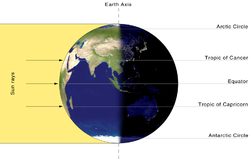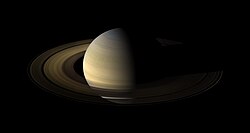Equinoxes on Earth

General
Systematically observing the sunrise, people discovered that it occurs between two extreme locations at the horizon and eventually noted the midpoint between the two. Later it was realized that this happens on a day when the duration of the day and the night are practically equal and the word "equinox" comes from Latin aequus, meaning "equal", and nox, meaning "night".
In the northern hemisphere, the vernal equinox (March) conventionally marks the beginning of spring in most cultures and is considered the start of the New Year in the Assyrian calendar, Hindu, and the Persian or Iranian calendars, [b] while the autumnal equinox (September) marks the beginning of autumn. [13] Ancient Greek calendars too had the beginning of the year either at the autumnal or vernal equinox and some at solstices. The Antikythera mechanism predicts the equinoxes and solstices. [14]
The equinoxes are the only times when the solar terminator (the "edge" between night and day) is perpendicular to the equator. As a result, the northern and southern hemispheres are equally illuminated.
For the same reason, this is also the time when the Sun rises for an observer at one of Earth's rotational poles and sets at the other. For a brief period lasting approximately four days, both North and South Poles are in daylight. [c] For example, in 2021 sunrise on the North Pole is 18 March 07:09 UTC, and sunset on the South Pole is 22 March 13:08 UTC. Also in 2021, sunrise on the South Pole is 20 September 16:08 UTC, and sunset on the North Pole is 24 September 22:30 UTC. [15] [16]
In other words, the equinoxes are the only times when the subsolar point is on the equator, meaning that the Sun is exactly overhead at a point on the equatorial line. The subsolar point crosses the equator moving northward at the March equinox and southward at the September equinox.
- The relation between the Earth, Sun, and stars at the March equinox. From Earth's perspective, the Sun appears to move along the ecliptic (red), which is tilted compared to the celestial equator (white).
- Diagram of the Earth's seasons as seen from the north. Far right: December solstice.
- Diagram of the Earth's seasons as seen from the south. Far left: June solstice.
Date
When Julius Caesar established the Julian calendar in 45 BC, he set 25 March as the date of the spring equinox; [17] this was already the starting day of the year in the Persian and Indian calendars. Because the Julian year is longer than the tropical year by about 11.3 minutes on average (or 1 day in 128 years), the calendar "drifted" with respect to the two equinoxes – so that in 300 AD the spring equinox occurred on about 21 March, and by the 1580s AD it had drifted backwards to 11 March. [18]
This drift induced Pope Gregory XIII to establish the modern Gregorian calendar. The Pope wanted to continue to conform with the edicts of the Council of Nicaea in 325 AD concerning the date of Easter, which means he wanted to move the vernal equinox to the date on which it fell at that time (21 March is the day allocated to it in the Easter table of the Julian calendar), and to maintain it at around that date in the future, which he achieved by reducing the number of leap years from 100 to 97 every 400 years. However, there remained a small residual variation in the date and time of the vernal equinox of about ±27 hours from its mean position, virtually all because the distribution of 24 hour centurial leap-days causes large jumps (see Gregorian calendar leap solstice).
Modern dates
The dates of the equinoxes change progressively during the leap-year cycle, because the Gregorian calendar year is not commensurate with the period of the Earth's revolution about the Sun. It is only after a complete Gregorian leap-year cycle of 400 years that the seasons commence at approximately the same time. In the 21st century the earliest March equinox will be 19 March 2096, while the latest was 21 March 2003. The earliest September equinox will be 21 September 2096 while the latest was 23 September 2003 (Universal Time). [12]
Names
- Vernal equinox and autumnal equinox: these classical names are direct derivatives of Latin (ver = spring, and autumnus = autumn). These are the historically universal and still most widely used terms for the equinoxes, but are potentially confusing because in the southern hemisphere the vernal equinox does not occur in spring and the autumnal equinox does not occur in autumn. The equivalent common language English terms spring equinox and autumn (or fall) equinox are even more ambiguous. [19] [20] [21] It has become increasingly common for people to refer to the September equinox in the southern hemisphere as the Vernal equinox. [22] [23]
- March equinox and September equinox: names referring to the months of the year in which they occur, with no ambiguity as to which hemisphere is the context. They are still not universal, however, as not all cultures use a solar-based calendar where the equinoxes occur every year in the same month (as they do not in the Islamic calendar and Hebrew calendar, for example). [24] Although the terms have become very common in the 21st century, they were sometimes used at least as long ago as the mid-20th century. [25]
- Northward equinox and southward equinox: names referring to the apparent direction of motion of the Sun. The northward equinox occurs in March when the Sun crosses the equator from south to north, and the southward equinox occurs in September when the Sun crosses the equator from north to south. These terms can be used unambiguously for other planets. They are rarely seen, although were first proposed over 100 years ago. [26]
- First point of Aries and first point of Libra: names referring to the astrological signs the Sun is entering. However, the precession of the equinoxes has shifted these points into the constellations Pisces and Virgo, respectively. [27]
Length of equinoctial day and night


On the date of the equinox, the center of the Sun spends a roughly equal amount of time above and below the horizon at every location on the Earth, so night and day [d] are about the same length. Sunrise and sunset can be defined in several ways, but a widespread definition is the time that the top limb of the Sun is level with the horizon. [28] With this definition, the day is longer than the night at the equinoxes: [7]
- From the Earth, the Sun appears as a disc rather than a point of light, so when the centre of the Sun is below the horizon, its upper edge may be visible. Sunrise, which begins daytime, occurs when the top of the Sun's disk appears above the eastern horizon. At that instant, the disk's centre is still below the horizon.
- The Earth's atmosphere refracts sunlight. As a result, an observer sees daylight before the top of the Sun's disk appears above the horizon.
In sunrise/sunset tables, the atmospheric refraction is assumed to be 34 arcminutes, and the assumed semidiameter (apparent radius) of the Sun is 16 arcminutes. (The apparent radius varies slightly depending on time of year, slightly larger at perihelion in January than aphelion in July, but the difference is comparatively small.) Their combination means that when the upper limb of the Sun is on the visible horizon, its centre is 50 arcminutes below the geometric horizon, which is the intersection with the celestial sphere of a horizontal plane through the eye of the observer. [29]
These effects make the day about 14 minutes longer than the night at the equator and longer still towards the poles. The real equality of day and night only happens in places far enough from the equator to have a seasonal difference in day length of at least 7 minutes, [30] actually occurring a few days towards the winter side of each equinox. One result of this is that, at latitudes below ±2.0 degrees, all the days of the year are longer than the nights. [31]
The times of sunset and sunrise vary with the observer's location (longitude and latitude), so the dates when day and night are equal also depend upon the observer's location.
A third correction for the visual observation of a sunrise (or sunset) is the angle between the apparent horizon as seen by an observer and the geometric (or sensible) horizon. This is known as the dip of the horizon and varies from 3 arcminutes for a viewer standing on the sea shore to 160 arcminutes for a mountaineer on Everest. [32] The effect of a larger dip on taller objects (reaching over 2½° of arc on Everest) accounts for the phenomenon of snow on a mountain peak turning gold in the sunlight long before the lower slopes are illuminated.
The date on which the length of day and night are exactly the same is known as an equilux; the neologism, believed to have been coined in the 1980s, achieved more widespread recognition in the 21st century. [e] At the most precise measurements, a true equilux is rare, because the lengths of day and night change more rapidly than any other time of the year around the equinoxes. In the mid-latitudes, daylight increases or decreases by about three minutes per day at the equinoxes, and thus adjacent days and nights only reach within one minute of each other. The date of the closest approximation of the equilux varies slightly by latitude; in the mid-latitudes, it occurs a few days before the spring equinox and after the fall equinox in each respective hemisphere. [37]
Unequal intervals between equinoxes
Because the movement of the Earth on its orbit obeys Kepler's laws of planetary motion, the interval from March equinox to September equinox is about 186 days, while the interval from September equinox to March equinox is about 179 days, which makes the polar day at the North Pole about 7 days longer than that at the South Pole. [38]
Auroras
Mirror-image conjugate auroras have been observed during the equinoxes. [39]
Cultural aspects
The equinoxes are sometimes regarded as the start of spring and autumn. A number of traditional harvest festivals are celebrated on the date of the equinoxes.
People in a large part of the former Persian Empire, in Iran, Afghanistan, Tajikistan and most of the Central Asia, celebrate the Persian new year, Nowruz, which is spring equinox in northern hemisphere. This day marks the new year in Solar Hijri calendar.
Religious architecture is often determined by the equinox; the Angkor Wat Equinox during which the sun rises in a perfect alignment over Angkor Wat in Cambodia is one such example. [40]
Catholic churches, since the recommendations of Charles Borromeo, have often chosen the equinox as their reference point for the orientation of churches. [41]






